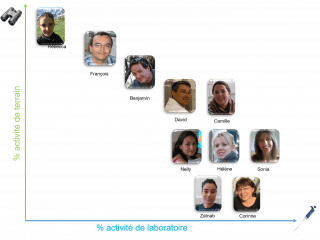Research assistance
Members

Assistante ingénieure
CNRS
Tel: 04 72 44 81 42

Ingénieure d'études
CNRS
Tel: 33 04 72 43 29 17
Technicien CDD
CNRS

Assistant ingénieur
UCBL
Adjointe technique
UCBL
Tel: 33 04 72 44 79 17

Assistant ingénieur
CNRS
Tel: 33 04 72 43 29 29

Assistante ingénieure
CNRS
Tel: 04 72 44 81 42

Ingénieure de recherche
CNRS
Tel: 33 04 72 43 29 14
Technicienne CDD
UCBL

Technicienne
UCBL
Tel: 33 04 72 43 29 15

Ingénieur d'études
CNRS
Tel: 33 04 72 44 58 72
Adjointe technique
UCBL
Tel: 04 72 44 81 42

Technicienne
CNRS
Tel: 04 72 44 81 42

Assistante ingénieure
UCBL
Tel: 04 72 43 29 14

Technicien
UCBL

Ingénieur de recherche
CNRS
Tel: 04 72 43 29 29

The “pole biotechnologique” brings together a range of bioengineering expertise for the development of tools and approaches for research in evolutionary biology; and operational competences to ensure their logistical and technical implementation.
Since it was set up, the biotechnology hub has perpetuated insect breeding activities, including several species of drosophila, but also Venturia and Bemisia for example. These breeding activities are carried out on artificial medium or plants. We ensure laboratory logistics (e.g. autoclave, stock management, ...) as well as safety aspects, and develop devices (e.g. via 3D printing) to feed experimental research in the laboratory focusing on evolutionary genomics, behavioural ecology and functional ecology.
Our expertise is also solicited to organize field work, in metropolitan France and internationally, and to carry out population monitoring of terrestrial mammals (e.g. roe deer, marmots, feral cats, bats) and birds (dipper). In addition to capture (e.g. trapping, netting), marking and monitoring of animals, we implement experimental approaches in natura, collect biometric, behavioral and physiological data, biological samples (blood, secretions, hair, faeces, biopsy, ...) and characterize the study environments (installation of sensors, aerial imaging by drones, construction of digital models of terrain ...).
Finally, the biotechnology hub offers the technical resources and skills to analyse a wide variety of biological samples in the laboratory through an multidisciplinary prism. The complementarity and synergy of our competences are expressed in the fields of molecular biology (PCR, qPCR, construction of libraries for the genesis of ohmic data), cell biology (confocal microscopy, flow cytometry), and biochemistry (characterization of metabolic, endocrine and oxidative profiles).
Rehabilitation work was done at the LBBE in 2022 and lead to a significant expansion of the experimental space. These new premises allow us to increase our capacity, to offer new spaces and modern tools dedicated to behavioral approaches. These new premises also allow us to widen the spectrum of our activities by developing new techniques (e.g. cell culture, Crispr/cas9, RNAi, ...).
In all our activities, we regularly welcome and supervise trainees and students of all levels. For any questions or information request, do not hesitate to contact us
Publications
Display of 61 to 90 publications on 259 in total
Regulation of Oxidative Phosphorylation of Liver Mitochondria in Sepsis
Cells . 11
Journal article
see the publicationThe morphological allometry of four closely related and coexisting insect species reveals adaptation to the mean and variability of the resource size
Oecologia . 200 ( 1-2 ) : 159-168
Journal article
see the publicationGenomic characterization of viruses associated with the parasitoid Anagyrus vladimiri (Hymenoptera: Encyrtidae)
Journal of General Virology . 103 ( 12 )
DOI: 10.1099/jgv.0.001810
Journal article
see the publicationInfluence of bacterial symbionts on host niche and ecological diversification: an integrative approach in a whitefly model
XXVI International Congress of Entomology .
Poster
see the publicationInfluence of secondary symbionts on host plant utilization and selection in the whitefly Bemisia tabaci.
10th congress of the International Symbiosis Society (ISS) - 3rd International Conference on Holobionts (joint meeting) .
Poster
see the publicationRole of symbionts in insects' ecological diversification: cytotype influences exploitation of an unfavorable host plant in the sap-feeder Bemisia tabaci (Hemiptera: Aleyrodidae).
Rencontres du Groupe Régional de Recherche en Microbiologie des Interactions (G-RREMI) 2022 .
Poster
see the publicationAnalyses of symbiotic bacterial communities in the plant pest Bemisia tabaci reveal high prevalence of Candidatus Hemipteriphilus asiaticus on the African continent
Peer Community Journal . 2 ( e20 )
Journal article
see the publicationDecline in telomere length with increasing age across nonhuman vertebrates: A meta‐analysis
Molecular Ecology . 31 ( 23 ) : 5917-5932
DOI: 10.1111/mec.16145
Journal article
see the publicationLarval density in the invasive Drosophila suzukii : immediate and delayed effects on life-history traits
Preprint
see the publicationThe oxidative cost of helping and its minimization in a cooperative breeder.
Behavioral Ecology . 33 ( 3 ) : 504-517
Journal article
see the publicationCo-variation between glucocorticoids, behaviour and immunity supports the pace-of-life syndrome hypothesis: an experimental approach
Proceedings of the Royal Society B: Biological Sciences . 289 ( 1975 ) : 20220464
Journal article
see the publicationDNA methylation as a tool to explore ageing in wild roe deer populations
Molecular Ecology Resources . 22 ( 3 ) : 1002-1015
Journal article
see the publicationVariations in immune parameters with age in a wild rodent population and links with survival
Ecology and Evolution . 12 ( 7 ) : e9094
DOI: 10.1002/ece3.9094
Journal article
see the publicationLitter characteristics and helping context during early life shape the responsiveness of the stress axis in a wild cooperative breeder
BioRxiv . 75 : 171
Journal article
see the publicationMechanical ventilation preserves diaphragm mitochondrial function in a rat sepsis model
Intensive Care Medicine Experimental . 9 ( 1 ) : 1-16
Journal article
see the publicationInteractions entre ruminants domestiques et sauvages - Parasitisme partagé et résistances
Journées Nationales des GTV .
Conference paper
see the publicationITS-2 rDNA metabarcoding in two isolated populations of roe deer (Capreolus capreolus) reveals variation in the nemabiome among age classes
28th International Conference of the World Association for the Advancement of Veterinary Parasitology .
Conference paper
see the publicationDealing with host and food searching in a diurnal parasitoid: consequences of light at night at intra‐ and trans‐generational levels
Insect conservation and diversity . 14 ( 2 ) : 235-246
DOI: 10.1111/icad.12477
Journal article
see the publicationDetection and monitoring of Drosophila suzukii in raspberry and cherry orchards with volatile organic compounds in the USA and Europe
Scientific Reports . 11 ( 1 )
Journal article
see the publicationMetabarcoding in two isolated populations of wild roe deer (Capreolus capreolus) reveals variation in gastrointestinal nematode community composition between regions and among age classes
Parasites & Vectors . 14 : 594
Journal article
see the publicationMaternal effects shape offspring physiological condition but do not senesce in a wild mammal
Journal of Evolutionary Biology . 34 ( 4 ) : 661-670
DOI: 10.1111/jeb.13768
Journal article
see the publicationShort-term telomere dynamics is associated with glucocorticoid levels in wild populations of roe deer
Comparative Biochemistry and Physiology - A: Comparative Physiology . 252 : 1-7
Journal article
see the publicationCytotype Affects the Capability of the Whitefly Bemisia tabaci MED Species To Feed and Oviposit on an Unfavorable Host Plant
mBio . 12 ( 6 ) : 1-16
Journal article
see the publicationWolbachia load variation in Drosophila is more likely caused by drift than by host genetic factors
Peer Community In Evolutionary Biology .
Journal article
see the publicationRole of symbionts in insects’ ecological diversification: cytotype influences exploitation of an unfavorable host plant in the sap-feeder Bemisia tabaci
DECRYPthèse E2M2 Edition 20 .
Conference paper
see the publicationRole of symbionts in insects’ ecological diversification: cytotype influences exploitation of an unfavorable host plant in the whitefly Bemisia tabaci (Hemiptera: Aleyrodidae)
Webinaires du Groupe Régional de Recherche en Microbiologie des Interactions (G-RREMI) 2021 .
Conference paper
see the publicationThe transposable element-rich genome of the cereal pest Sitophilus oryzae
BMC Biology . 19 ( 1 ) : 241
Journal article
see the publicationTransposable element activity in the transcriptomic analysis of mouse pancreatic tumors
Preprint
see the publicationValidation of the predation-stress hypothesis in a large mammal
Functional Ecology . 34 ( 5 ) : 942-943
Journal article
see the publicationHow consistent is RAD‐seq divergence with DNA‐barcode based clustering in insects?
Molecular Ecology Resources . 20 ( 5 ) : 1294-1298
Journal article
see the publication